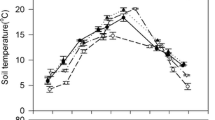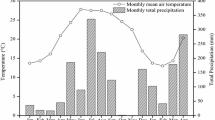Abstract
Respiration rates and chemical characteristics of soil organic layers were measured at 40 experimental plots, 5 sampling sites per plot, in a moderately polluted Niepołomice Forest, S. Poland. The respiration rate was positively related to pH, water content and concentrations of Ca and K, and negatively to Ntot, Zn and Pb (p < 0.001 for all variables). No significant correlation was found between the respiration rate and Na, Cu or Cd (p > 0.25 in all cases). The regression model explained 73% of the total variance. Analysis of variance components revealed that ca. 35% of the total variance in the respiration rate can be explained by the vegetation types covering the area: oak-hornbeam vs. pine-oak forests. The next 40% was explained by the variability between sampling plots and the remaining 25% by within-plot variability among sampling sites. Similar results were obtained for water content. The variance in pH was split 30%:39%:31% between vegetation types:plots:sampling sites. No variance in Ca and Na was explained by the forest type, and approximately half of the variance was due to between-plot and half to within-plot variability. In contrast, potassium concentration differed between forest types (58% variance explained), more than 25% of total variance was due to between-plot variability and only 15% due to within-plot variability. For Zn the results were 1%, 66% and 33%, for Cu 0%, 38% and 62%, for Pb 48%, 18% and 34%, and for Cd 0%, 33% and 67%, respectively. The study clearly shows (1) substantial variance in some soil characteristics between sampling sites and (2) a different split of variance among spatial scales for different soil characteristics.
Similar content being viewed by others
References
Bååth E. 1989. Effects of heavy metals in soil on microbial processes and populations (a review). Water Air Soil Pollut. 47: 335–379.
Bååth E., Berg B., Lohm U., Lundgren B., Lundkvist H., Roswall T. et al. 1980. Effects of experimental acidification and liming on soil organisms and decomposition in a Scots pine forest. Pedobiologia 20: 85–100.
Berg B. 1986. Nutrient release from litter and humus in coniferous forest soils-a mini review. Scand. J. For. Res. 1: 359–369.
Berg B., Ekbohm G., Söderström B. and Staaf H. 1991. Reduction of decomposition rates of Scots pine needle litter due to heavy metal pollution. Water Air Soil Pollut. 59: 165–177.
Berg B., Hannus K., Popoff T. and Theander O. 1982. Changes in organic chemical components of needle litter during decompositin. Long-term decomposition in a Scots pine forest I. Can. J. Bot. 60: 1310–1319.
Berg B. and Lundmark J.E. 1987. Decomposition of needle litter in Pinus contorta and Pinus sylvestris monocultures – a comparison. Scand. J. For. Res. 2: 3–12.
Berg B., McClagherty C. and Johansson M. 1993. Litter mass-loss rates in late stages of decomposition at some climatically and nutritionally different pine sites. Long-term decomposition in a Scots pine forest VIII. Can. J. Bot. 71: 680–692.
Berg B. and Staff H. 1980. Decomposition rate and chemical changes in decomposing needle litter of Scots pine. II. Influence of chemical composition. In: Persson T. (ed.), Structure and function of northern coniferous forests. Ecological Bulletin, pp. 373–390.
Coleman D.C. and Crossley A. 1996. Fundamentals of Soil Ecology. Academic Press, Inc, San Diego, California, USA.
Cotrufo M.F., Ineson P. and Roberts J.D. 1995. Decomposition of birch leaf litters varying C-to-N ratios. Soil Biol. Biochem. 27: 1219–1221.
Couteaux M.-M., Bottner P. and Berg B. 1995. Litter decomposition, climate and litter quality. Trends Ecol. Evol. 10: 63–66.
Dwyer L.M. and Merriam G. 1981. Influence of topographic heterogeneity on deciduous litter decomposition. Oikos 37: 228–237.
Freedman B. and Hutchinson T. 1980. Effects of smelter pollutants on forest leaf litter decomposition near a nickel-copper smelter at Sudbury, Ontario. Can. J. Bot. 58: 1722–1736.
Gibson D.J. 1986. Spatial and temporal heterogeneity in soil nutrient supply measured using in situ ion-exchange resin bags. Plant and Soil 96: 445–450.
Grodziński W., Weiner J. and Maycock P.F. (eds) 1984. Forest Ecosystems in Industrial Regions. Springer Verlag, Heidelberg.
Grodziński W. and Yorks T.P. 1981. Species and ecosystem level bioindicators of airborne pollution: an analysis of two major studies. Water Air Soil Pollut. 16: 33–53.
Hågvar S. 1988. Decomposition studies in an easily constructed microcosm: effects of microarthropods and varying soil pH. Pedobiologia 31: 293–303.
Janssens I.A. and Ceulemans R. 1998. Spatial variability in forest soil CO2 efflux assessed with a calibrated soda lime technique. Ecology Letters 1: 95–98.
Kabata-Pendias A. and Pendias H. 1999. Biogeochemia pierwiastków śladowych PWN S.A. Warszawa.
Kleczkowski A.S. (ed.) 1981. Resources of the natural environment of the Niepołomice Forest and problem of its protection (In Polish, English summary). Studia Osrodka Dokumentacji Fizjograficznej, IX.
Kuzel S., Nydl V. and Kolar L. 1993. Spatial variability of cadmium, pH, organic matter in soil and its dependence on sampling scale. Water Air Soil Pollut. 78: 51–58.
Laskowski R., Maryański M. and Niklińska M. 1994. Effect of heavy metals and mineral nutrients on forest litter respiration rate. Environ. Pollut. 84: 97–102.
McClagherty C.A. and Berg B. 1987. Cellulose, lignin and nitrogen concentrations as rate regulating factors in late stages of forest litter decomposition. Pedobiologia 30: 101–112.
Meentemeyer V. 1978. Macroclimate and lignin control of litter decomposition rates. Ecology 59: 465–472.
Melillo J.M., Aber J.D. and Muratore J.F. 1982. Nitrogen and lignin control of hardwood leaf litter decomposition dynamics. Ecology 63: 621–626.
Nordgren A., Bååth E. and Söderström B. 1983. Microfungi and microbial activity along a heavy metal gradient. Appl. Environ. Microbiol. 45: 1829–1837.
Polhemus N.W. 2001. Statistical analysis using Statgraphics Plus. Basic statistical methods. Vol. 1. Stat-Point, LCC, Englewood Clifs, New Jersey, USA.
Schlesinger W.H. 1991. Biogeochemistry. An Analysis of Global Change. Academic Press, San Diego, California, USA.
Strojan C.L. 1978. Forest leaf litter decomposition in the vicinity of a zinc smelter. Oecologia 32: 203–212.
Swift M.J., Heal O.W. and Anderson J.M. 1979. Decomposition in Terrestrial Ecosystems. Blackwell Scientific Publications, Oxford.
Taylor B.R., Parkinson D. and Parsons W.F.J. 1989. Nitrogen and lignin content as a predictors of litter decay rates: a microcosm test. Ecology 70: 97–104.
Taylor B.R., Prescott C.E., Parsons W.J.F. and Parkinson D. 1991. Substrate control of litter decomposition in four Rocky Mountain coniferous forests. Can. J. Bot. 69: 2242–2250.
Weiner J. 1999. The Niepolomice Forest – 50 years of ecosystem changes in an industrial region. In: Long term ecological – examples, methods, perspectives for Central Europe. Proc. ILTEDR Workshop, 16–18 Sept. 1998, Madralin, 153.
Weiner J., Fredro-Boniecki S., Reed D., Maclean A. and Strong M. 1997. Niepolomice Forest – a GIS analysis of ecosystem response to industrial pollution. Environ. Pollut. 98: 381–388.
Xu M. and Qi Y. 2000. Effect of spatial scale on relationship between plant species richness and microclimate in a forested ecosystem. Pol. J. Ecol. 48: 77–88.
Rights and permissions
About this article
Cite this article
Laskowski, R., Niklińska, M., Nycz-wasilec, P. et al. Variance components of the respiration rate and chemical characteristics of soil organic layers in Niepołomice Forest, Poland. Biogeochemistry 64, 149–163 (2003). https://doi.org/10.1023/A:1024976200218
Issue Date:
DOI: https://doi.org/10.1023/A:1024976200218




